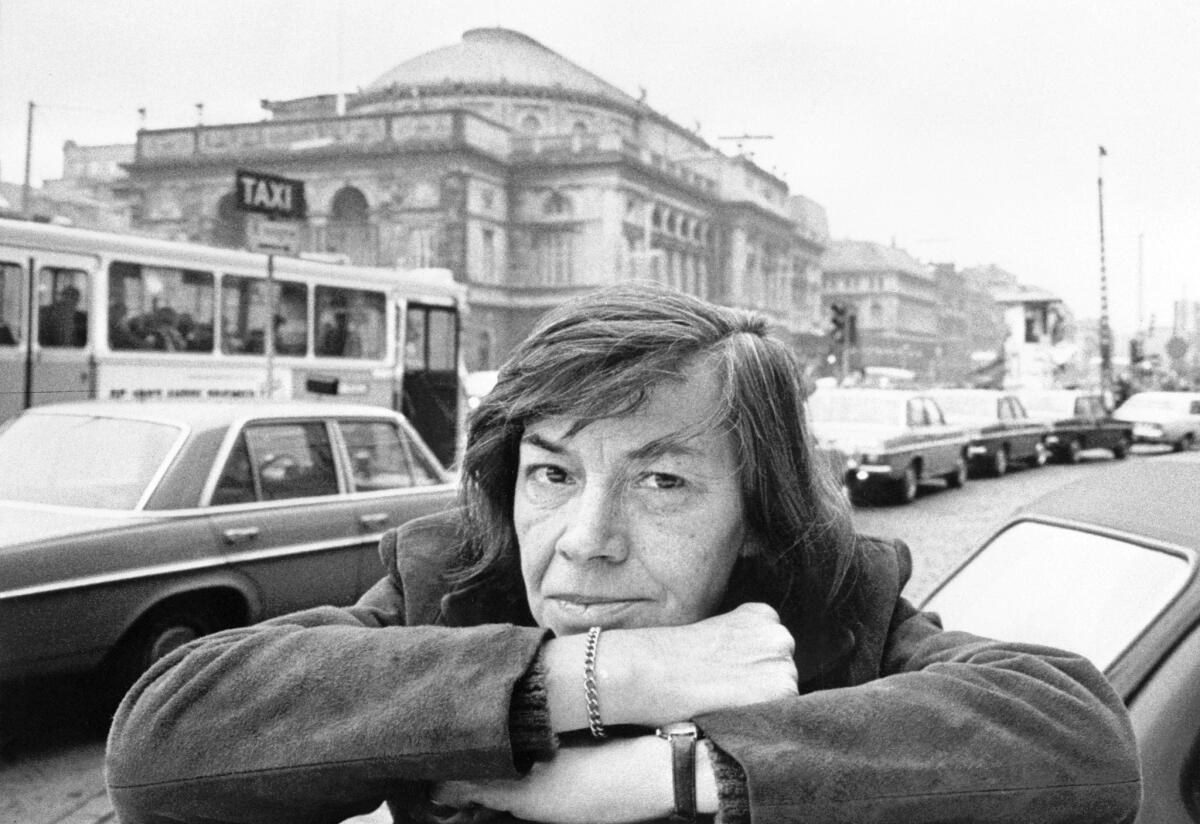What Patricia Highsmith did for love: ‘The Price of Salt’ and the secrets behind ‘Carol’

- Share via
Patricia Highsmith, the Dark Lady of American Letters, worked her 1956 Olympia Portable typewriter violently enough to wipe the letter “E” right off its keyboard.
Her approach to love was just as extreme.
She compared falling in love to being “shot in the face.” Love was a “madness,” a “disease.”
She died for love a thousand times in life and killed for it over and over again in her novels. What she couldn’t do with love was live with it.
“Eternal love,” Pat wrote, “is my biggest problem” — and she made it everyone else’s problem too. She didn’t separate the love that was natural to her from her other “natural” feelings: the homicidal ones. (It was her women lovers she wanted to kill; the men merely annoyed her.)
In notebooks, she allowed love and murder to mix her a heady emotional martini — and iced the lethal drink up with art. “Murder is a kind of making love … my hands upon her throat (which I should really like to kiss)....”
But if you’re lucky enough to pick up the one Highsmith novel with romantic love as the subject — “The Price of Salt” (published in 1952; adapted to film as “Carol”) — you’ll sense right away what homicide did for Highsmith’s loving feelings. How it sauced and spiced her amorous connections with the desire to create a romantic coupling in her own prowling style: hunter and hunted, lover and killer.
Judy Tuvim, Pat’s precocious high school friend (who became the actress Judy Holliday), introduced her to Marcel Proust’s crimes of the heart when they were teenagers in Manhattan. And Proust’s broken love chord ripples through all Pat’s work.
But only “The Price of Salt,” her most unusual novel, was inspired by a Proustian strike of illicit love: a two-minute transaction in Bloomingdale’s in the Christmas season of 1948 with Kathleen Wiggins Senn, a “blondish and elegant” married woman from New Jersey.
And only Pat’s Proust-like sense-memories of her amour fatal of 1946-47 — Virginia Kent Catherwood, a lovely, wayward, redheaded heiress from a prominent Philadelphia Main Line family — allowed her to sink her whole self in her book.
It helped that Ginnie Catherwood resembled a less definite edition of Katharine Hepburn — and had more than a dash of Hepburn’s less defined tastes. For a year of bliss and bale, she was Pat’s “Philadelphia Story”; after that, her Muse for Life.
Only Patricia Highsmith could phrase a novel of life-changing love in the language of Jack the Ripper.
— Joan Schenkar
Pat’s encounter with the blond Mrs. Senn and her reveries of redheaded Ginnie perfused her imagination in the same week she entered Freudian psychoanalysis. Enterprising but ambivalent, she was auditioning another kind of redhead: the handsome British novelist she’d met at Yaddo, Marc Brandel. He was already beginning to irritate her.
And so the “The Price of Salt” — the first modern novel to offer its women lovers a desirable future — was imagined while its author was (a) engaged to a man and (b) attempting to exorcise the erotic obsessions that inspired her.
Pat’s psychoanalyst (spare a moment to pity the woman) was preparing her devious patient for happy heterosexuality by herding her into a therapy group of married women attracted to women. Citing the “alcoholic who joined AA when he ran out of drinking companions,” Pat toyed luxuriously with “seducing a couple of them.”
“Better latent than never,” said Ann Smith, the lovely painter Pat was sleeping with behind her fiance and therapist’s backs.
“The Price of Salt” was Pat’s second published work; it’s the only Highsmith novel without a homicide in it.
But “Salt” lays love out on the autopsy table Pat usually reserved for murder, and its crisply sophisticated dialogue and richly figured prose (styles of expression Pat would never use so deftly again) drip with the desire to do damage.
Pat borrowed elements for “Salt” from her debut novel, “Strangers on a Train” (1950), and subdued them to her story of requited lesbian love — the only “crime” she left out of her other fictions. But requited love in Highsmith Country glows with a luminous halo of incest, a little light pedophilia and sexual consummations that are spied upon, recorded, menaced and stalked.
Only Patricia Highsmith could phrase a novel of life-changing love in the language of Jack the Ripper.
Carol Aird, “Salt’s” alluring blond beauty, keeps a gun in her glove box, turns a detective’s pursuit on its head and has the courage and cruelty to give up her child for her jailbait-aged, artistic, equally stubborn girlfriend, Therese Belivet.
Viewers of “Carol” who become readers of “Salt” will find unexpected complications of character in the lambencies of print — and Carol’s friend and former lover, Abby, circles Carol and Therese like a wolverine drawn to a campfire. Highsmith loved a good triangle.
But her two attractive, successful women lovers were as new an idea for the American novel in 1952 as Tom Ripley’s criminalizing of the American Dream would be three years later.
Therese, a teenage set designer with an unsatisfactory boyfriend, takes the same “Christmas rush” job in a grand Manhattan department store that Pat herself had taken in December 1948, when Kathleen Senn, swathed in mink and slapping her gloves “absently” into the palm of one hand, sauntered up to Pat’s counter to order a doll for her daughter.
Struck to the heart (and vacillating between presenting this ravishing creature with a wedding bouquet or heading for her with a hunting knife), Pat naturally wanted to close her hands “tightly” around Senn’s throat.
“Uplifted as though I had seen a vision,” Pat wrote in her notebook, and spiking with fever, she went home and poured out the entire plot of “The Price of Salt” in two hours and eight pages. Therese, she said, came straight from her “own bones” while the image of Kathleen Senn dissolved into Pat’s lost love Ginnie Catherwood to produce the novel’s cool, controlling Carol Aird.
But Pat feared the love-stroke that rescued her inner life — “How grateful I am … not to spoil my best thematic material by transposing it to a false male-female relationship,” she wrote to remind herself — would sink her professional reputation. Her terror at publishing a career-wrecking “lesbian novel” in midcentury America shook her to her shoes.
She began to confuse living it up with writing it down. She forced her feelings and disordered her senses. She drunk-dialed sexual encounters by the dozens, then drank some more to forget them. Her blackouts lasted for days.
She couldn’t stop writing “Salt,” and she wouldn’t face publishing it. She attacked her friends and lovers right where they loved.
And then things really went bad.
Pat seduced the longtime female lover of Margot Johnson, her loyal literary agent; confessed the affair to Johnson (havoc ensued), then slept with the formidable theatrical representative who modeled for a character in “The Tropic of Cancer” when she was Henry Miller’s petite amie in Paris.
Pat — her archery still excellent — confessed this affair to her new lover’s lover.
Among this lover’s clients were Bertolt Brecht, Kurt Weill, Lotte Lenya, Maria Irene Fornes and, in the 1980s (at the end of her theater career and the beginning of mine), Joan Schenkar.
And one sunny afternoon in Switzerland, I opened a Highsmith diary at random and read Pat’s sulphurous description of what my dignified, brilliant, long-dead play agent looked like in 1948 when she was young, naked and in flagrante in Highsmith’s narrow bed.
Rolling into London in the scented spring of 1949, Pat celebrated the English sale of “Strangers on a Train” by kissing her new publisher’s wife and seducing the Irish girlfriend of her old Manhattan mentor.
She was enchanted, she said, with the effect this double indemnity had on her writing.
By now, Pat had long been “in love” with her witty, withholding creation Carol Aird — whose marital situation, character traits, love affairs and physical features she was siphoning as directly as a blood donation from the life of Ginnie Catherwood.
Although Pat didn’t use her private writings about Ginnie in “Salt,” their beautiful urgency — as personal as her inked finger pressed on a page — swell the book’s similes.
“My green and red goddess, my jade and garnet, my moss and hollyberry … my marrow and my blood, my stop and go baby, I adore you … I kiss you … I defy you ever not to love me....”
And that is how Patricia Highsmith, obsessively private and wedded to her art (the only faithful marriage she made), opened her life to public judgment in the most harrowing way.
She published it.
Having successfully obscured her authorship (she signed “Salt” with a mild-mannered pseudonym, Claire Morgan, dedicated it to three people whose names she invented, and sailed to Europe before publication), Pat didn’t return to the scene of her “crime.” She continued to treat her lyrical little masterpiece as something shameful, denying her authorship for the next four decades.
Meanwhile, the book sold hundreds of thousands of copies.
In 1990, when “Salt” finally appeared in her name, Pat changed the title to “Carol.” It was another kind of deniability.
Judging by the fan letters she received, many of her eager and (mildly) misled readers saw “Salt” as a life-enhancing narrative of successful lesbian love: the first of its kind.
But what they were actually getting from this quintessential outsider artist was something even more interesting: A Letter to the World from Highsmith Country in which, for the length of one novel at least, all of Pat’s terrors, talents and hostilities to love deliquesced into a paean to beauty, an ode to the outlawed, a hymn to ambivalence and the postscripted hope of an ecstatic and permanent union — “Carol, in a thousand cities,” Therese calls it — without, for a single moment, denying the dangerous world in which that union would be taking place or the sometimes violent and always equal power-struggle between the two women lovers at its center.
Nor does “The Price of Salt” deny the homicidal heart of Patricia Highsmith herself, who, for once in her life and for love alone, confined her murders to her metaphors.
Schenkar’s latest book is Patricia Highsmith’s authorized literary biography, “The Talented Miss Highsmith.” She is working on a history of “The Price of Salt.”
More to Read
Sign up for our Book Club newsletter
Get the latest news, events and more from the Los Angeles Times Book Club, and help us get L.A. reading and talking.
You may occasionally receive promotional content from the Los Angeles Times.








